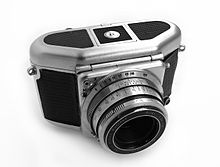Heinz Kilfitt
Heinrich Wilhelm Kilfitt , usually short Heinz Kilfitt , (born May 27, 1898 in Höntrop , † November 8, 1980 in Munich ) was a German camera designer.
Live and act
Kilfitt was born in 1898 to a watchmaker. Even in his youth he was repairing clocks and was interested in optics and photography. He learned the watchmaking trade in his father's business. He then began his professional career at the Rudolf Neumann Optical Institute in Berlin and later became head of the photography department.
In 1931, inspired by the Leica camera, Kilfitt developed the prototype of a 35mm camera for the 24x24 mm format, which he offered to Agfa and Kodak in vain. Finally, in Hans-Heinrich Berning, a business partner was found who contributed the idea of a spring mechanism to the project and financed its further development.
H.-H. Berning founded Otto Berning & Co in Schwelm / Westphalia with a design office in Düsseldorf. From 1934 onwards, the development of an automatic 35mm camera with a spring mechanism - the robot - was advanced and made ready for series production. When the political climate in Germany changed in 1939, Kilfitt sold his patents and company shares to Berning.
In 1940 Kilfitt acquired the company NEDO Optik in Munich and built - later in Vaduz, Liechtenstein - unusual lenses for cameras and photographic accessories. His lenses quickly achieved world renown, also in film production. Walt Disney had Kilfitt lenses used in documentaries in the 1950s and 1960s.
Kilfitt became known worldwide for its outstanding macro and long-range lenses, which could also be used on many other camera systems via adapters. In 1948 the Vaduz camera company developed the Kilar, which was further developed in 1954 to become the world's first macro lens, the Macro Kilar. In 1959 he built the zoom lens developed by Frank G. Back, the Voigtländer Zoomar . In 1964, Kilfitt founded the Kilfitt Optical Factory in Munich.
Kilfitt was also involved in the development of other high-quality cameras such as the Alpa and the Rectaflex . In the early 1950s he designed the distinctive Mecaflex SLR camera , which was manufactured by Metz Apparatefabik in Fürth. In the forties to sixties prototypes for a 6x6 camera were created. Based on Kilfitt's concept, one of these cameras was later built in Japan as the Fujita 66 .
Web links
- https://www.cameraquest.com/kilzoom.htm (English)
- http://www.robot-camera.de/RoBoT_Historie/Heinz_Kilfitt/heinz_kilfitt.html
Individual evidence
| personal data | |
|---|---|
| SURNAME | Kilfitt, Heinz |
| ALTERNATIVE NAMES | Kilfitt, Heinrich Wilhelm |
| BRIEF DESCRIPTION | German camera designer |
| DATE OF BIRTH | May 27, 1898 |
| PLACE OF BIRTH | Höntrop |
| DATE OF DEATH | November 8, 1980 |
| Place of death | Munich |
